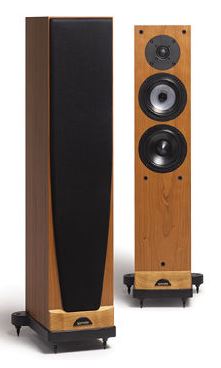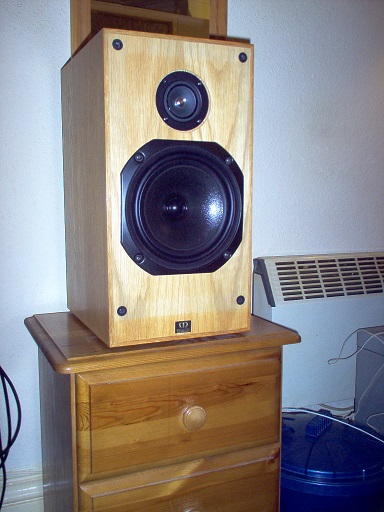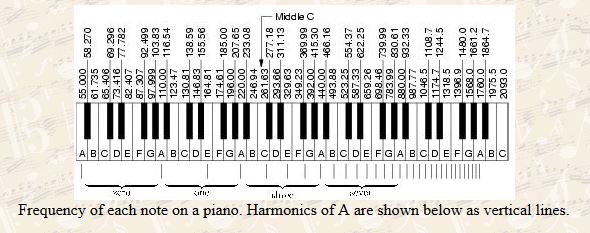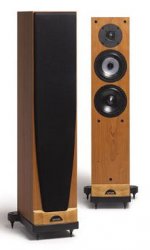Hi all, not a regular contributor on here,but at a standstill as to how to approach the bright sound of a recently acquired set of Soendor S5e speakers in my listening area. Bought these without a demo,as my friend uses a set with an all naim set up and they sounded great.
Mine are used with an arcam cd73, buffer pre and Avondale audio monoblocks.
Used in a 18 X 12 room but they fire across room at narrower part approx 9ft wide. Room has wooden floor with sofa opposite and dining table etc in room.
The spendors are regarded as being pretty neutral so was surprised they come across bright in my room??
Any suggestions or mods would be greatly appreciated,
Thanks.
Mine are used with an arcam cd73, buffer pre and Avondale audio monoblocks.
Used in a 18 X 12 room but they fire across room at narrower part approx 9ft wide. Room has wooden floor with sofa opposite and dining table etc in room.
The spendors are regarded as being pretty neutral so was surprised they come across bright in my room??
Any suggestions or mods would be greatly appreciated,
Thanks.
Maybe you don't like neutral. Maybe your room acoustics don't favour neutral speakers. Either way, if you need eq action the easiest way is to lower the output of the tweeters by changing the resistors in the lpad to increase attenuation.
Hi guys,not being technically minded but have a reasonable grasp of electronics,can someone explain in easy terminology?
Can supply pics of the speakers,they are a 3 way design?
Cheers.
Can supply pics of the speakers,they are a 3 way design?
Cheers.
just had a "google" look.
are you running them with grills on or off? reason i ask is the brightness may be from diffraction they've got a pretty sharp corner at the front edge.
are you running them with grills on or off? reason i ask is the brightness may be from diffraction they've got a pretty sharp corner at the front edge.
question i would ask myself is did the designer/manufacturer intend for the product to be used with the grill "on" or "off".
sometimes things like grills are chosen and compensated for in the design process.
what could it hurt to listen to them with the grills on if it softens the "bright".
the grill frames may change the diffraction character and reduce the "brightness" your currently experiencing.
grills can prevent inquisitive small fingers and dog noses and cat claws and even keep things like lego's from being introduced into bass ports...
sometimes things like grills are chosen and compensated for in the design process.
what could it hurt to listen to them with the grills on if it softens the "bright".
the grill frames may change the diffraction character and reduce the "brightness" your currently experiencing.
grills can prevent inquisitive small fingers and dog noses and cat claws and even keep things like lego's from being introduced into bass ports...
Last edited:
Maybe to swap out the Elna Cerafine capacitors from the otherwise very nice Arcam...
Those things are just to bright, thin, harsh, and brittle sounding imo.
If you ever want to really make for some truly smooth and detailed midrange, find some of the Burson V4 modules to replace the njm2114.
Those things are just to bright, thin, harsh, and brittle sounding imo.
If you ever want to really make for some truly smooth and detailed midrange, find some of the Burson V4 modules to replace the njm2114.
was this how your friend was running them?Grills off thought this was best way to listen to them??
"they are a 3 way design?" - 2.5 way, so the BSC should be already sorted:
Spendor S5e loudspeaker | Stereophile.com
although 5" does not a woofer make.. However I'd suggest your room may be the culprit... may need to pad down the tweeter a bit?
Spendor S5e loudspeaker | Stereophile.com
although 5" does not a woofer make.. However I'd suggest your room may be the culprit... may need to pad down the tweeter a bit?
Last edited:
It's a Spendor S5E. Below. I think the room placement is the culprit too. It's worth thinking about the reflections. You are mostly interested in the first wavefront to arrive, the rest is just clutter. Which is why the middle of the room can be a good place to put the speakers.

That and the bare floorboards and the overly-lively rest of it. Good placement and some soft carpet and furnishings and curtains could tame this a lot. ER, subject to WAF. 😀
That and the bare floorboards and the overly-lively rest of it. Good placement and some soft carpet and furnishings and curtains could tame this a lot. ER, subject to WAF. 😀
Attachments
Edwar, The simplist way to trim a tweeter's excessive brightness without fiddling with the crossover or the room acoustics is to fit a small piece of cotton wool in front of the tweeter.
It may seem a little unsophisticated but the simplicity of it is effective. You will just need to experiment a little with the thickness and use the grill cloth as a support. Sometimes the simplist of things work the best.
C.M
It may seem a little unsophisticated but the simplicity of it is effective. You will just need to experiment a little with the thickness and use the grill cloth as a support. Sometimes the simplist of things work the best.
C.M
Thick carpet on most of the floor. Easiest solution. Really. Will absorb more higher than lower frequencies, and the tonal balance in the room will become somewhat darker. If that doesn't cut it, use an equalizer somewhere in the chain, and turn the treble down a notch and/or the bass up a notch. I use Sonos connect. The equalizer in the Sonos software works great. For more advanced equalization, look into minidsp or the driverack units from DBX. Gives you room correction too.
Grilles on, for sure here!
H1280-06 22TFF
Those little wide dispersion 3/4" tweeters will lose a lot of lateral power from a grille. It's designed in. It's only the fanatics who take the grille off and swear it sounds better. Well, it doesn't. It just sounds louder. 🙄
FWIW, wide dispersion (small) tweeters always do sound bright. It's because they put a lot of power out off-axis, which then finds its way to your ears via room reflections.
Sounds like a plan. You can also get out your measuring tape and get into the audiophoolery that is the Cardas Guide: Cardas Room Setup Guide
You end up with a listening triangle. Well, don't we all? 😎
But for sure, you need some soft furnishings. These mostly affect the bit above 1kHz, as it goes. Because the effectiveness of an absorber only kicks in when you get above 1/4 wavelength thickness. 3kHz is 2.5 cms 1/4 vavelength, as it goes. More effective at glancing angles. But I like heavy drapes behind my head.
Bear in mind that above 1kHz, most of the speaker output is in a forward direction. You don't have to worry about any rear output, so the backwall affects things less at the top end. Toe-in is another thing to play with. I think toe-in is a bit fanatical and selfish. 😀
H1280-06 22TFF
Those little wide dispersion 3/4" tweeters will lose a lot of lateral power from a grille. It's designed in. It's only the fanatics who take the grille off and swear it sounds better. Well, it doesn't. It just sounds louder. 🙄
FWIW, wide dispersion (small) tweeters always do sound bright. It's because they put a lot of power out off-axis, which then finds its way to your ears via room reflections.
Spendor S5e loudspeaker | Stereophile.comstereophile said:As it turned out, the best results in my 12' by 19' music room were with the Spendors placed 68" from the rear wall and 24" from each side wall, aimed directly at the listening seat. Moving the listening position a little farther from the speakers helped flatten and extend the bass response, as did varying the distance between the speakers and the side walls—although I continued to fight either a 3dB peak at 100Hz or a diminished version of the aforementioned dip at 160Hz.
Read more at Spendor S5e loudspeaker | Stereophile.com
Sounds like a plan. You can also get out your measuring tape and get into the audiophoolery that is the Cardas Guide: Cardas Room Setup Guide
You end up with a listening triangle. Well, don't we all? 😎
But for sure, you need some soft furnishings. These mostly affect the bit above 1kHz, as it goes. Because the effectiveness of an absorber only kicks in when you get above 1/4 wavelength thickness. 3kHz is 2.5 cms 1/4 vavelength, as it goes. More effective at glancing angles. But I like heavy drapes behind my head.
Bear in mind that above 1kHz, most of the speaker output is in a forward direction. You don't have to worry about any rear output, so the backwall affects things less at the top end. Toe-in is another thing to play with. I think toe-in is a bit fanatical and selfish. 😀
System7 sometimes your like a wind up toy that's overcranked, let you go and get outta the way!😀
I don't make this stuff up. The great enemy of good sound is, in fact, our wives. AKA WAF. 😀
An empty and bare room is about the worst environment for sound. Why? Echoes.
Guaranteed to wreck even conversation. Never mind HiFi. 🙄
It crosses my mind that putting the cotton wool in our ears rather than on the tweeters here might help. It's what I used to do at loud Led Zeppelin concerts. 😎
An empty and bare room is about the worst environment for sound. Why? Echoes.
Guaranteed to wreck even conversation. Never mind HiFi. 🙄
It crosses my mind that putting the cotton wool in our ears rather than on the tweeters here might help. It's what I used to do at loud Led Zeppelin concerts. 😎
sorry i was just making an observation that when a topic is in your wheelhouse you can be like the energizer bunny!😀
I wasn't at all offended, trust me. It's probably true. 🙂
Let's just look at the issues here in a simple way, what is this? A 5" polycone Spendor S5e 2.5 way with 3/4" fabric tweeter, allegedly my preferred third order BW3 crossover which has wide dispersion at crossover albeit some lobing issues which should average out:

Spendor are a highly competent company, but have little control over your listening space or placement.
My own taste is wall mounting with less bafflestep (bass boost) and narrower dispersion:

It's less room sensitive. And toe-in is less necessary.
When judging the sound or describing where a fault is, it is good to have an idea what frequency musical instruments commonly work at:


Of course, the 2nd and 3rd harmonics which define the timbre are higher. But the fundamentals are low, aren't they? I can judge a speaker pretty quickly by playing a familiar piece like the first Dire Straits. I know how it should sound on good equipment in a sensible room.
IMO, you don't fix any issues with new speaker cable, capacitors or different amplifiers, though it is clear the spendor impedance is quite difficult. They could do better there IMO.
Let's just look at the issues here in a simple way, what is this? A 5" polycone Spendor S5e 2.5 way with 3/4" fabric tweeter, allegedly my preferred third order BW3 crossover which has wide dispersion at crossover albeit some lobing issues which should average out:
Spendor are a highly competent company, but have little control over your listening space or placement.
My own taste is wall mounting with less bafflestep (bass boost) and narrower dispersion:
It's less room sensitive. And toe-in is less necessary.
When judging the sound or describing where a fault is, it is good to have an idea what frequency musical instruments commonly work at:
Of course, the 2nd and 3rd harmonics which define the timbre are higher. But the fundamentals are low, aren't they? I can judge a speaker pretty quickly by playing a familiar piece like the first Dire Straits. I know how it should sound on good equipment in a sensible room.
IMO, you don't fix any issues with new speaker cable, capacitors or different amplifiers, though it is clear the spendor impedance is quite difficult. They could do better there IMO.
OT: the 22TFF is a bit of an unsung hero, damn good value for money. Have no inclination to swap them out of my main system even though I have 'better' tweeters available
Grilles on, perhaps you could put some tissue paper on the inside to tame the tweeters a bit?
Re:"energizer bunny!" - I'll have what he's having.... Just got back from a fortnight in NZ, so laid back, don't know how I'll cope when I get back to the grindstone on Monday...
Grilles on, perhaps you could put some tissue paper on the inside to tame the tweeters a bit?
Re:"energizer bunny!" - I'll have what he's having.... Just got back from a fortnight in NZ, so laid back, don't know how I'll cope when I get back to the grindstone on Monday...
Last edited:
- Status
- Not open for further replies.
- Home
- Loudspeakers
- Multi-Way
- taming bright speakers
